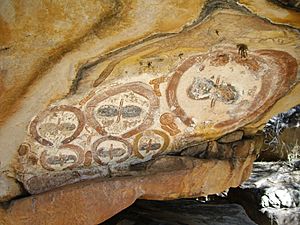Wandjina facts for kids
The Wandjina (also called Wanjina or Wondjina) are powerful cloud and rain spirits from Australian Aboriginal mythology. You can see them clearly in ancient rock art found in Australia. Some of these artworks in the Kimberley region of Western Australia are about 4,000 years old! There's also a related spirit called Wunngurr. This spirit is like the Rainbow Serpent found in other Aboriginal beliefs, but it has its own special meaning.
The stories of the Wandjina and their artwork are still very important to the Mowanjum Community of Aboriginal people. They are a basic part of the culture for the Wanjina Wunggurr cultural group. This group includes four different Aboriginal peoples in the Kimberley area.
Contents
Ancient Stories of Wandjina
Some Dreamtime stories say that the Wandjina created the land and all the living things in it. They also say these spirits still have power over everything. When the Wandjina spirits were ready to leave the world, they painted their pictures on cave walls. Then, they went into a nearby waterhole. Aboriginal people would later repaint these images. This was a way to bring new life and energy back to the world.
The Wandjina can also bring strong weather like floods, lightning, and cyclones. This happens if people do not follow the rules or laws.
Wandjina and Wunggurr Beliefs
The Wandjina and Wunggurr spirits are super important to the Wanjina Wunggurr cultural group. This group includes the Worrorra, Wunambal, and Ngarinyin peoples in the Kimberley. Rock paintings of Wandjina, and also the Gwion Gwion paintings, show that these groups share a common culture. The Wunambal people in the Mitchell Plateau area call Wandjina by another name: Gulingi.
Wunggurr is a special kind of Rainbow Serpent belief. It represents a powerful creator spirit. Wandjina, on the other hand, are local spirits. They are connected to specific places and families (clans). Sometimes, people use the words "Wandjina" and "Wunggurr" to mean the same thing. However, Wunggurr is actually a wider life force. It is the power that gives life to everything, including the Wandjina themselves. One part of Wunggurr is shown as a rock python called Wanjad.
Traditional Rock Artworks
The Wandjina rock art uses broad, wide strokes. This style of art started about 3,800 to 4,000 years ago. This was after a very long dry period (a drought) ended. The climate then became wetter with regular monsoon rains.
Wandjina paintings usually use black, red, and yellow colors on a white background. The spirits are shown alone or in groups. They can be painted up and down or side to side, depending on the rock's shape. Sometimes, they are shown with other figures or objects. These can include the Rainbow Serpent or yams (a type of vegetable).
Wandjina figures often have large upper bodies and heads. Their heads might show eyes and a nose, but usually no mouth. There are two main ideas why they don't have mouths. One is that they are so powerful they don't need to speak. The other is that if they had mouths, the rain would never stop! Around the heads of Wandjina, you can see lines or blocks of color. These show lightning coming out of what looks like transparent helmets.
Today, people still believe these paintings have special powers. Because of this, they must be treated with great respect. Every art site and painting has its own name. The Aboriginal people of the Mowanjum community repaint these images. This helps to keep the Wandjina's presence alive and strong.
Repainting also happens every December or January. According to Mowanjum belief, this helps make sure the monsoon rains arrive. Some sites have been repainted so many times that the paint is over 40 layers thick! The painting style has changed over time. Newer figures are often wider, and some now even have eyelashes.
Wandjina on Bark Paintings
In the late 1960s and early 1970s, some artists from the Mowanjum community started painting traditional Wandjina on pieces of string bark. These bark paintings were mostly sold through the mission at Kalumbaru. Some important artists from this area include Alec Mingelmanganu, Charlie Numbelmoore, and Jack Karedada. Today, these artworks are in major museum collections around the world.
Other Ways Wandjina Appear
Wandjina spirits were the idea behind a children's fantasy TV show in 1966. It was called Wandjina! and was made by ABC Television.
In 2007, graffiti art showing Wandjina appeared in Perth, Western Australia. The styles varied, from stencil art to a spray-painted Wandjina driving a pink car. People used websites like Flickr and blogs to document these "wandering Wandjina." They called it "Wandjina watching." This graffiti made some Indigenous people angry and upset. They said that only certain artists from their community are allowed to paint Wandjina. A short film, Who Paintin' Dis Wandjina, talked about how Aboriginal people reacted to this.
Pictures of the Wandjina are also shown on the walls of the Ringwood Magistrates Court in Victoria. These images were created by the National Gallery of Victoria.
In 2016, during the Vivid Sydney festival, artwork of Wandjina by artist Donny Woolagoodja was projected onto the Sydney Opera House. This was part of its special Lighting of the Sails celebration.
The Wandjina are mentioned as rain spirits in the 2022 novel Music in the Mirrors.
See also
 In Spanish: Wondjina para niños
In Spanish: Wondjina para niños
- Indigenous Australian art
- Weather god
- List of Stone Age art
- List of rain deities




